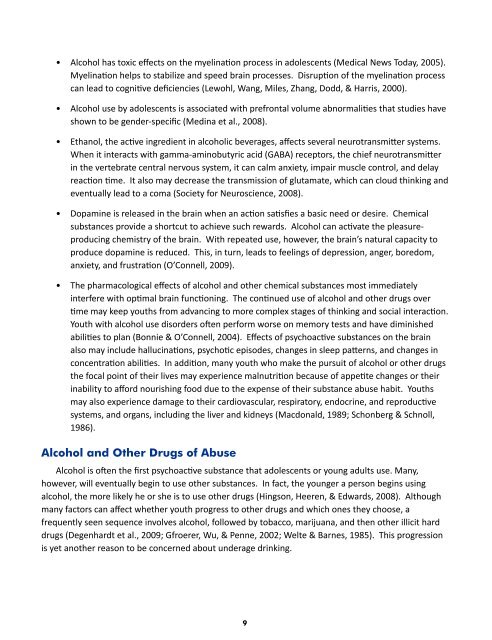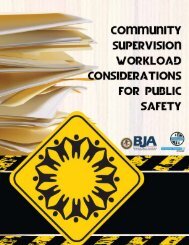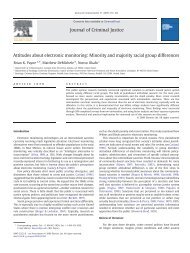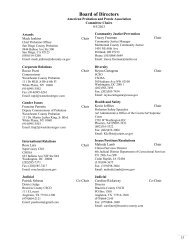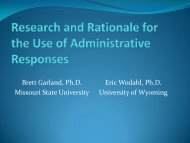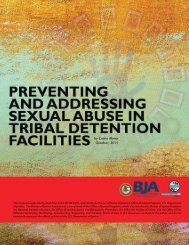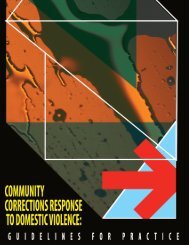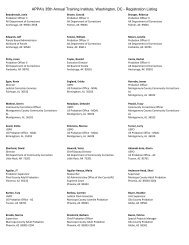Intervention Principles and Practice Guidelines for - Underage ...
Intervention Principles and Practice Guidelines for - Underage ...
Intervention Principles and Practice Guidelines for - Underage ...
You also want an ePaper? Increase the reach of your titles
YUMPU automatically turns print PDFs into web optimized ePapers that Google loves.
• Alcohol has toxic effects on the myelination process in adolescents (Medical News Today, 2005).<br />
Myelination helps to stabilize <strong>and</strong> speed brain processes. Disruption of the myelination process<br />
can lead to cognitive deficiencies (Lewohl, Wang, Miles, Zhang, Dodd, & Harris, 2000).<br />
• Alcohol use by adolescents is associated with prefrontal volume abnormalities that studies have<br />
shown to be gender-specific (Medina et al., 2008).<br />
• Ethanol, the active ingredient in alcoholic beverages, affects several neurotransmitter systems.<br />
When it interacts with gamma-aminobutyric acid (GABA) receptors, the chief neurotransmitter<br />
in the vertebrate central nervous system, it can calm anxiety, impair muscle control, <strong>and</strong> delay<br />
reaction time. It also may decrease the transmission of glutamate, which can cloud thinking <strong>and</strong><br />
eventually lead to a coma (Society <strong>for</strong> Neuroscience, 2008).<br />
• Dopamine is released in the brain when an action satisfies a basic need or desire. Chemical<br />
substances provide a shortcut to achieve such rewards. Alcohol can activate the pleasureproducing<br />
chemistry of the brain. With repeated use, however, the brain’s natural capacity to<br />
produce dopamine is reduced. This, in turn, leads to feelings of depression, anger, boredom,<br />
anxiety, <strong>and</strong> frustration (O’Connell, 2009).<br />
• The pharmacological effects of alcohol <strong>and</strong> other chemical substances most immediately<br />
interfere with optimal brain functioning. The continued use of alcohol <strong>and</strong> other drugs over<br />
time may keep youths from advancing to more complex stages of thinking <strong>and</strong> social interaction.<br />
Youth with alcohol use disorders often per<strong>for</strong>m worse on memory tests <strong>and</strong> have diminished<br />
abilities to plan (Bonnie & O’Connell, 2004). Effects of psychoactive substances on the brain<br />
also may include hallucinations, psychotic episodes, changes in sleep patterns, <strong>and</strong> changes in<br />
concentration abilities. In addition, many youth who make the pursuit of alcohol or other drugs<br />
the focal point of their lives may experience malnutrition because of appetite changes or their<br />
inability to af<strong>for</strong>d nourishing food due to the expense of their substance abuse habit. Youths<br />
may also experience damage to their cardiovascular, respiratory, endocrine, <strong>and</strong> reproductive<br />
systems, <strong>and</strong> organs, including the liver <strong>and</strong> kidneys (Macdonald, 1989; Schonberg & Schnoll,<br />
1986).<br />
Alcohol <strong>and</strong> Other Drugs of Abuse<br />
Alcohol is often the first psychoactive substance that adolescents or young adults use. Many,<br />
however, will eventually begin to use other substances. In fact, the younger a person begins using<br />
alcohol, the more likely he or she is to use other drugs (Hingson, Heeren, & Edwards, 2008). Although<br />
many factors can affect whether youth progress to other drugs <strong>and</strong> which ones they choose, a<br />
frequently seen sequence involves alcohol, followed by tobacco, marijuana, <strong>and</strong> then other illicit hard<br />
drugs (Degenhardt et al., 2009; Gfroerer, Wu, & Penne, 2002; Welte & Barnes, 1985). This progression<br />
is yet another reason to be concerned about underage drinking.<br />
9


